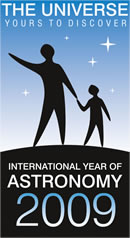SLT Update:
Click the Results page to see your handiwork.
Team, we need a complete copy of the SQM readings for every night from each school! Even if you think your school's team sent it in, please re-send one complete SQM Recording Form (with at least the average values) to the planetarium. This is your final task for Let There Be Night. Thank you.
August 17: IYA Podcast Features LTBN Team
A daily podcast at http://365daysofastronomy.org/ features members of the LTBN team. Check out the podcast that aired August 17, 2009.
Also, the LTBN model is on display at Villa Macri (right) in preparation for the Telescope Renaissance on August 28 at Toscana Park. Hope to see some of you there.
9 June: The 3D LEGO Model Goes on Display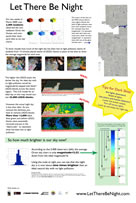

The LEGO model is in place at the Harris Branch Library for Summer 2009.
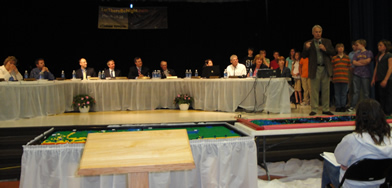 May 11: Students Unveil LEGO Model
May 11: Students Unveil LEGO Model
Members of the Student Leadership Team explained several aspects of Let There Be Night at the PHM School Board meeting. They then unveiled the LEGO model that depicts how much of the night sky has been lost. See results.html.
.
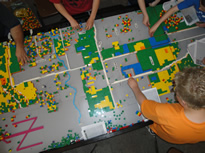
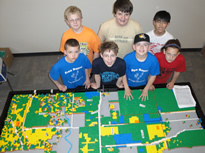 6 May 2009 Meeting
6 May 2009 Meeting
We're getting close to completion! Several team members continue to show up to help build the model. Earlier in the day, Bittersweet students had built thousands of LEGO stacks for the team to put into place.
Astronomy in our community: For upcoming events related to astronomy, see What's Up?
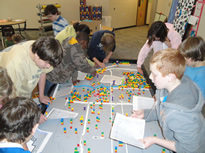 2 May 2009 Meeting
2 May 2009 Meeting
Several things were happening concurrently, and even though the tasks were not all glamorous, the team worked well together. First, we used improved printouts of the data to check the placement and color of the existing stacks of LEGO blocks on the board. Meanwhile, a team of "factory workers" labored to build stacks of LEGO blocks to fill in the gaps between the data points. Also, pairs of SLT members continued placing stacks in their proper positions, particularly in the northern sections.
The handouts with LTBN Analysis were just delivered, so they needed to be prepared for distribution to all students in grades 3-8.
Thanks go to the SLT members who helped count them out so we can get them into the hands of teachers on Monday.
On the the southern section of the model, team members began "smoothing" the data by interpreting the value between two or more observed estimates and filling in the gaps. The display is taking shape, but there's still a lot of smoothing to be done with tens of thousands of LEGO blocks .
Shown at left are many of the SLT members who helped on Saturday. Behind them are some of their staunchest supporters--parents waiting in line to pick them up. Thank you, parents, too.
We're not done yet, though we're getting closer. We still need to smooth out the gaps. If you can make it to any additional gatherings around the board (which would be posted above), that's great. And if not, we understand. Thank you for all you have given to this project thus far.
 28 April 2009 Meeting
28 April 2009 Meeting
It was time to continue building the LEGO model by matching up recorded student observations with specific locations on the LEGO base. Each of 18 base plates (left) was accompanied by an image with the data points shown on a photo of the square. The team then placed the colored LEGO blocks onto the approximate locations.
For some of the squares with greater populations (e.g., square 7 by Bittersweet and Moran schools), the data points were crowded together and smeared into each other. In those locations, a team member used Google Earth to resolve the individual data points and to place accurately the stack of LEGO blocks. This challenging task was supported by a parent, many of whom have assisted the Let There Be Night program. We thank you all.
After we get the actual data points plotted and we photograph the board, the team will interpolate between the data points.They will estimate the value of the sky glow between known points and place LEGO blocks to fill the whole board. They will have to tweak this "smoothed" version of the map to fill in the 1x1 and 1x2 LEGO gaps.
For the Saturday, May 2, meeting, a handful of people will continue working on the dense areas while other Team members fill in the gaps on the southern portion of the map. Thank you for your patience, students, as we try to work everyone into a role around the board with its limited space.
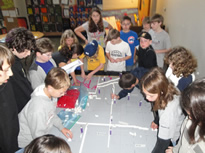 18 April 2009 Meeting
18 April 2009 Meeting
After viewing initial results from the community-wide science experiment, the team hauled out the LEGO base. Eager hands laid down and labeled the main roads, the St. Joseph River, the 14 schools, and the north indicator. An assembly line started making stacks of blocks in the ROYGBIV sequence.
After one day of preparing the base, it's looking ready to be filled in. Now we just have to plot the results akin to the Google Earth version (right).

In subsequent meetings, some team members will split from the LEGO table to prepare for the May 11th school board meeting.
SLT Members Receive St. Joseph County Resolution
The St. Joseph County Council passed Bill No. 30-09 on April 14, 2009, issuing congratulations on the LTBN community-wide science experiment. SLT members received the award on behalf of all students who contributed observations.
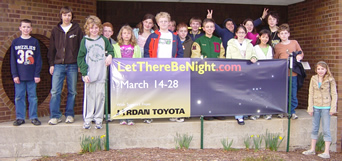 1 April 2009 Meeting
1 April 2009 Meeting
With the assistance of Mrs. Beth Raker, the team entered and tranferred SQM Records to a combined spreadsheet.
They then prepared some of the collected LEGO blocks for use in the 3D model.
SLT Members Meet With St. Joseph County Council
On March 24, 2009, five SLT members met with the St. Joseph County Council to describe the three aspects of light pollution; to suggest why they should care and what's at risk; to explain the LTBN community-wide experiment, both by thousands of students from their backyards and by SLTs at school grounds; and to suggest what St. Joseph County can do to mitigate its light pollution. The Council generously received our group and afterward asked questions about local lighting issues.
LTBN is Underway!
Hey, team, I'm having trouble keeping up with all the action going on at each school, especially with all the great weather we've had the first week. Always check the LTBN home page for events like satellite passes, which I won't add here on the Team page.
Please enter any thoughtful comments at Cindi Clawson's WNDU blog at http://www.wndu.com/blogs/cindi/41227747.html. There is also a feature story on LTBN there.
[Can't keep up. Just see your school's web page, which is linked from the PHM map at
http://www.lettherebenight.com/phm.html .]
Tuesday, March 17, pictures are at grissom.html.
Monday, March 16, picture is at waltdisney.html.
Sunday, March 15, pictures are at schmucker.html.
Saturday, March 14, pictures are at maryfrank.html.
More photos (courtesy of Lauren Parker) will be at meadows.html when I get time.
Stuff We Barely Mentioned...
- As the teams meet at the schools, please begin to take an inventory of both the good outdoor lighting and poor outdoor lighting on your school grounds. For the May 11th PHM School Board meeting you may be asked to make recommendations. Consider promoting the good lighting you see as well as discouraging the bad.
- Just what the heck are the SQM units, magnitudes per square arc second? The links at the bottom of the NightVision page may be of interest to SLT members. In particular, see what the SQM measures and a description of magnitudes per square arc-second.
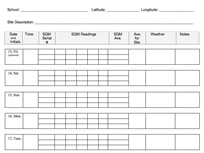 School Recording Form for SQM Readings
School Recording Form for SQM Readings
The Student Leadershp Team (SLT) from each school is responsible for insuring all three Sky Quality Meters (SQMs) are used on the school grounds each night--cloudy or clear--from March 14 to 28, 2009. Students will take five readings with each meter and write down their data on the school recording form for SQM readings. The team will also observe Orion from the school grounds and record the matching magnitude chart number. We encourage all SLT members to participate in this continous data collection, for this is an integral part of the science experiment.
7 March Meeting
Okay, Mr. Bueter has been barking about taking pictures; now he forgot to take any on Friday.
Again the SLT met in two groups. We had some housekeeping and attendance to do. Then Mr. Klinger and the team walked through the School Recording Form for SQM readings. At the planetarium we had a lot of good questions to discuss. The Discovery team told about projects being done by most 8th graders. Even a Lite-Brite helps tell a story. We unveiled a sample web page at /phm.htm, which has an interactive map of the school disctrict. Some students suggested they would pursue some large local entities to participate in Earth Hour. After a final bit of cheerleading by Mr. Klinger and Mr. Bueter, it was on to the good stuff--a laser show!
At Schmucker Middle School while we were awaiting all teams, a student told of his science fair project using the Little Dipper to measure light pollution. Mr. Bueter went off on a tangent about the altitude of Polaris, the latitude of the observer, and ten degrees in a fist.A paper plate activity illustrates the altitude of the noon sun. He also suggested you can use a paper plate to find the northern stars, including the Little Dipper, for any date and time. But we digress. [Thank you, teacher of Room 320 in Schmucker, for the use of your room.]
Again the teams talked about what different schools and students are doing. One school is turning off some lights in the hallways and classrooms preceding the Saturday of Earth Hour, March 28. Others are doing the Turtle Hatch Activity and others are doing their own original activities. Hey, take pictures.
At both sites we announced news of a City of Mishawaka Proclamation. Mayor Jeffrey L. Rea "proclaims March 28, 2009, Let There Be Night, Earth Hour Day in the City of Mishawaka."
28 February Meeting
The team split into two groups--half at the planetarium and half at Schmucker Middle School. The students shared some of the LTBN events happening in their schools (and out) since we last met, including science fair projects (at Horizon and Prairie Vista), meeting with Mishawaka's Mayor Rea, poetry written, announcements made (e.g., at Meadow's Edge), plans to turn off lights in the hallways before Earth Hour, LEGO blocks collected, and more.
The push is on to collect LEGO blocks and to start visiting businesses to support Earth Hour!
In the planetarium we connected by video live with Dr. Connie Walker, an astronomer at the National Optical Astronomy Observatory in Tucson, AZ. She shared with us the challenges of light pollution for our national observatories atop Kitt Peak, thanked students for participating actively in LTBN and creating a model for other communities to follow, and answered some excellent questions from the students.
To conclude both meetings, we asked the team members to predict how much of the night sky has been lost, now that they know more about the issues involved.In a new twist, we placed a dish with six layers of Jello representing the six magnitudes (akin to the LEGO block stacks) on top of a local map.
Some team members scraped away the equivalent of the lost stars. On their paper plates were mostly the upper purple and blue layers of Jello, which mirrored the prediction by some students of what to expect with the LEGO model. When we had to finish eating the Jello before dismissal, students for the first time asked if they could have "more light pollution, please. "
Thank you to the many SLT members who turned in their Checklist from the past meeting.
7 February 2009 Meeting
So students are aware of the tasks and timelines their teachers face, Mr. Klinger handed out the Instructions for Teachers. Under the planetarium dome the team practiced matching the stars of Orion against the Six Magnitude Charts. They also answered questions about using the Student Recording Form, on which they (and all students in grades 3-8) will record each night the number of the Magnitude Chart that matches their night sky.
Note: Each Student Leadership Team will also use their school's Sky Quality Meters (SQMs) to record five readings with each meter. Observers will write down all five readings from each meter and average the values later. Not every person from the team needs to be there, but from among the team you need coverage for your selected site every night March 14-28, whether cloudy or clear.
Our experiment asks, how much of the night sky have we already lost? Because we are measuring the darkness (or brightness) of the night in magnitudes, our answer will also be in magnitudes. To show visually the amount our community measured, in magnitudes, we want to build a 3D model out of LEGO blocks. Ours would be regular-size 2x2 blocks (not Duplo, as shown).
Each school's team got together to make a plan for a LEGO drive at their school. If you weren't at the Saturday meeting, please see a teammate. Below are some possible posters to print out, but we encourage you to make your own.
By request, we ran the turtle demo again, and it was still fun to watch.
To insure that everyone is checking out a few key items, we asked parents to sign off on a Checklist to be returned at the February 28th meeting in the planetarium (or after Enrichment).
We also discussed Earth Hour, which occurs the final night of our observations, March 28, 2009, from 8:30 p.m. to 9:30 p.m. Check out Earth Hour for Kids for a cool perspective on a warming idea.
Students and Mayor Share Their Ideas
A few days after the SLT met at the planetarium, members from several schools met with Mishawaka Mayor Jeff Rea to discuss LTBN and Earth Hour. The team did a great job of presenting the program and sharing what was important to them. Some details are at /earthhour.html. Thank you, all.
Posters for Earth Hour and the LEGO Collection
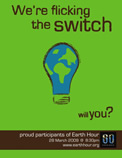 New Earth Hour Poster (right) is available for participating Earth Hour sites in 2009.
New Earth Hour Poster (right) is available for participating Earth Hour sites in 2009.
Four new posters, below, are available for schools and other collection sites. LTBN student teams are gathering the blocks to make a 3-D model of the results.
Observations during Globe at Night (GaN) are March 14-28, 2009. Note that GaN itself begins on Monday, but we are grabbing the preceding non-school Saturday night as well.
Hear the Podcast: Let There Be Night is featured on the "Gosh Dim It All!" podcast, which was broadcast by the New Media Working Group of the International Year of Astronomy 2009. You can also find it and daily astronomy podcasts at 365 Days of Astronomy. Scroll down to (or find in the Archives) the podcast for Sunday, January 18, 2009.
New blog for Team at http://goshdimit.blogspot.com/. Go ahead and leave your comments. It is only occasionally updated thus far. If you send me an original post, I will upload it on your behalf.
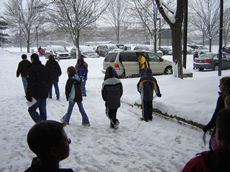 10 January 2009 Meeting
10 January 2009 Meeting
In spite of snowy conditions, a high number of families braved the elements to attend the second meeting of the LTBN Student Leadership Team at the PHM Planetarium. If you did not make it--and understandably so--no cause for worry. Every school was represented, so you can consult your teammates for an update.
Under the dome we looked at the stars of winter, including Orion, Taurus and the Pleiades, Sirius in Canis Major, and Capella in Auriga. We simulated light pollution conditions; watched Using an SQM (on Disc 2); practiced using SQMs; reviewed the Family Activity Packet; perused some online resources, including I Touch Map; and rehearsed the Maglite demonstration.
The teams and parents combined forces to run the Turtle Hatch activity while three students recorded the results of two trials on paper plates. We'll show those results here when we get some time. Several teams suggested they would bring the activity back to their respective schools.
We discussed inititating Earth Hour in our community. Together we will contact our elected representatives, community businesses, and individuals to turn out lights for one hour on the final day of the Orion star hunt. Earth Hour is March 28, 2009, from 8:30 p.m. to 9:30 p.m. Students interested in taking a lead role in contacting local officials and community representatives are asked to contact Chuck Bueter so we can coordinate efforts.
A handout at the end of this meeting offered instructions and information. Thanks to the parents who worked so hard to get to the planetarium in spite of the weather. For those who understandably couldn't make it, please check out the handout and contact a teammate from your school who attended.
13 December 2008 Meeting
Dear Student Leadership Team Member,
Welcome to the team of students who will lead our community in carrying out the Let There Be Night program. We're excited about the opportunities this presents to the families and school district alike.
At the December 13, 2008, meeting in the PHM Planetarium, Art Klinger presented an introduction to dark sky issues; conducted the Maglite demo to show the glare, light trespass, and sky glow that results from unshielded light; and presented a laser show on Orion the hunter. 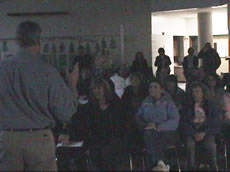
To parents and students alike, Chuck Bueter presented an introduction to the Let There Be Night program; the roles of students; events in the community, and other opportunities. Images from his presentation are at LTBN-SLT1.pdf (large file, at 81MB). All students received their 2-DVD set as they departed (right), as well as a handout with some notes, links, and contact information.
Eventually you students will provide content for this webpage. Below is simply an excerpt from the PHM Families page. Please peruse some of the links here. If you have questions, feel free to write them down and bring them to the next meeting. You may also contact us before then by email:
![]()
If you can't make the next team meeting (and we realize that happens), please email us in advance to let us know. Remember, you've got team members from your school in this with you, so you'll have to work with them to get what you missed.
Thanks for being onboard.
Chuck Bueter and Art Klinger
Coordinators of Let There Be Night
Let There Be Night Student Leadership Team
Let There Be Night (LTBN) seeks one team of 5 students from each PHM school. Teachers will make recommendations to the school principal, who will name the final candidates. One teacher from each building will oversee the team operation.
The team will meet:
- at the PHM Planetarium several times before Globe at Night begins; dates TBA
- at a designated location on school grounds every night March 14-28, 2009 to measure light pollution with SQM Meters
- at the PHM Planetarium after March 28, 2009,
- at the May 11, 2009, PHM School Board Meeting
Participants should:
- be responsible and reliable,
- be interested in a practical application, hands-on-science experiment quantifying light pollution
- be candidates for a science fair project and eligible for the regional fair (though no science fair project is required),
- have a supportive parent(s) who can provide transportation as needed.
Each Leadership Team will manage its school’s three hand-held Sky Quality Meters(SQMs), which are available for independent science fair projects. During the Globe at Night (GaN) campaign, March 14-28, the team will take SQM readings from the same spot every night on school grounds, cloudy or clear. Not all team members need to be together these two weeks, but amongst themselves the team must have coverage for every night. They will also observe the constellation Orion and estimate light pollution by comparing the number of stars they see from school with several Orion star charts of varying brightness. Observations must be after astronomical twilight, which is approximately 9:30 p.m. in late March.
The teams will meet initially for a thorough introduction to outdoor lighting issues and LTBN. They will help manage the data within their respective schools during Globe at Night's Orion star count. The team will correlate the sky glow observed with the naked eye by their classmates with sky glow measured by the meter. They will meet again to build a model that conveys the results of the community-wide investigation. And they will present the results and any recommendations to the PHM School Board on May 11, 2009.
Globe at Night: Students will view sky charts at and send their results to www.globe.gov/GaN/.
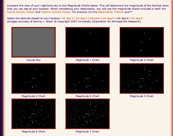 Family packets (in English and in several other languages) can be downloaded from the Globe at Night Parent Information Page. There you can preview Orion star charts, which you will compare to the view outside your backyard.
Family packets (in English and in several other languages) can be downloaded from the Globe at Night Parent Information Page. There you can preview Orion star charts, which you will compare to the view outside your backyard.
Links:
- Globe at Night
Orion star count resources support LTBN and 2009 International Year of Astronomy - I Touch Map
Easily find latitude and longitude to four decimal points for your viewing site. - Galileo's Vision
See the key observations that convinced Galileo that the old model no longer worked. - Earth Hour encourages businesses, governments, and residents to turn off lights March 28, 8:30-9:30 PM
- PHM Planetarium Clear Sky Clock
Weather prediction for PHM area confirms good viewing times
- Astronomical Twilight
Calendar shows when the sun has set far enough (astronomical twilight) that sky is at its darkest
- PHM Planetarium & Air/Space Museum
Before or after your visit, explore online some of the national treasures and exhibits on display in the PHM Planetarium - Spaceweather
Current happenings and photographs of astronomy stuff you can see, like aurorae, comets, noctilucent clouds, and sunspots - Heavens-Above
Find out when the International Space Station and other satellites glide over your location. Then go outside and wave to the passing astronauts.
- YMCA AstroCamp
Spend a week stargazing with telescopes at a Michigan summer camp
- Observing Highlights & Sky Chart
See what's hapening in the night sky this week
- Local student projects:
- Sorry Starry Night compares sky before and after retail development
- Students investigate lighting issues and share findings with classmates
- Dark Sky Team compares nightly SQM values at astronomical twilight (coming soon)
- Ideas for student-directed projects (from Night Vision)
- Ideas for local projects (from Let There Be Night)
- Siemens We Can Change the World Challenge offers opportunity for small student teams.
Globe at Night: Students will view sky charts at and send their results to www.globe.gov/GaN/.
Go outside and look up. Here's a Night Sky Planner from NASA.

